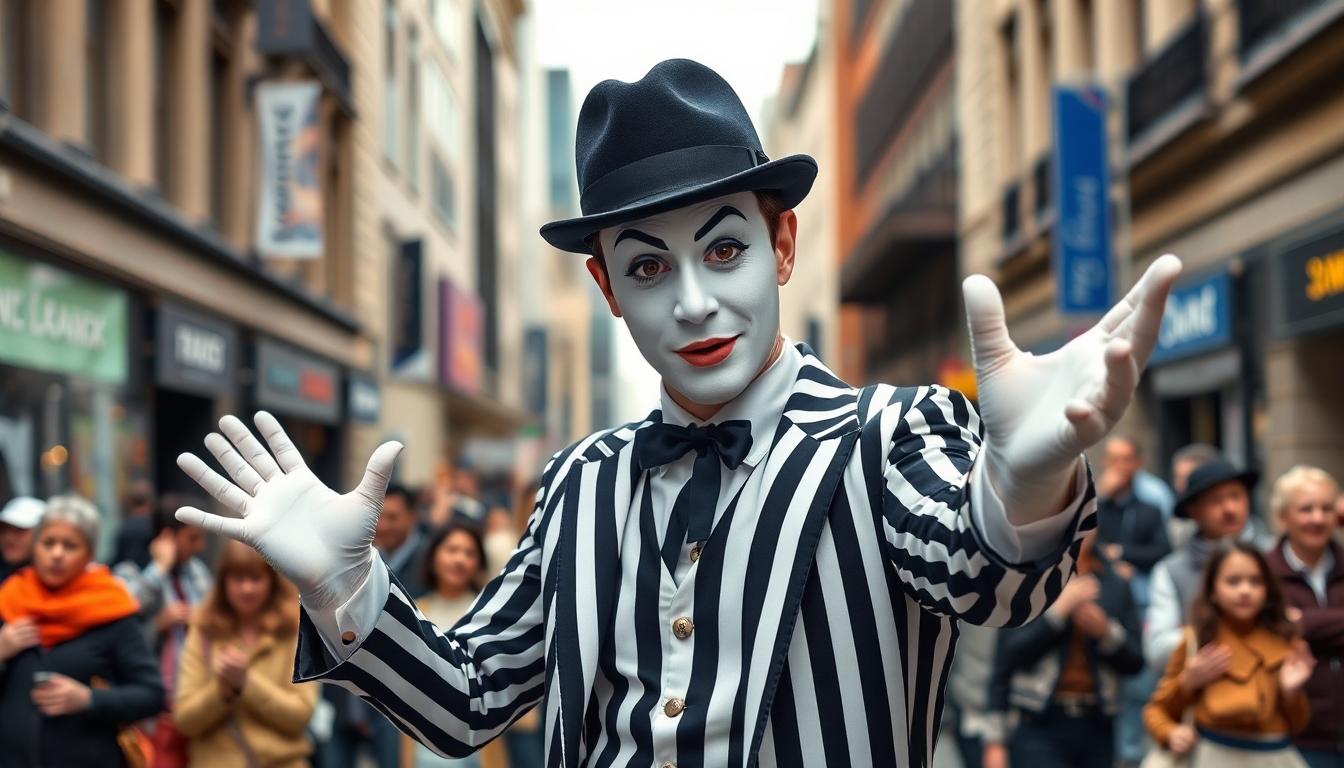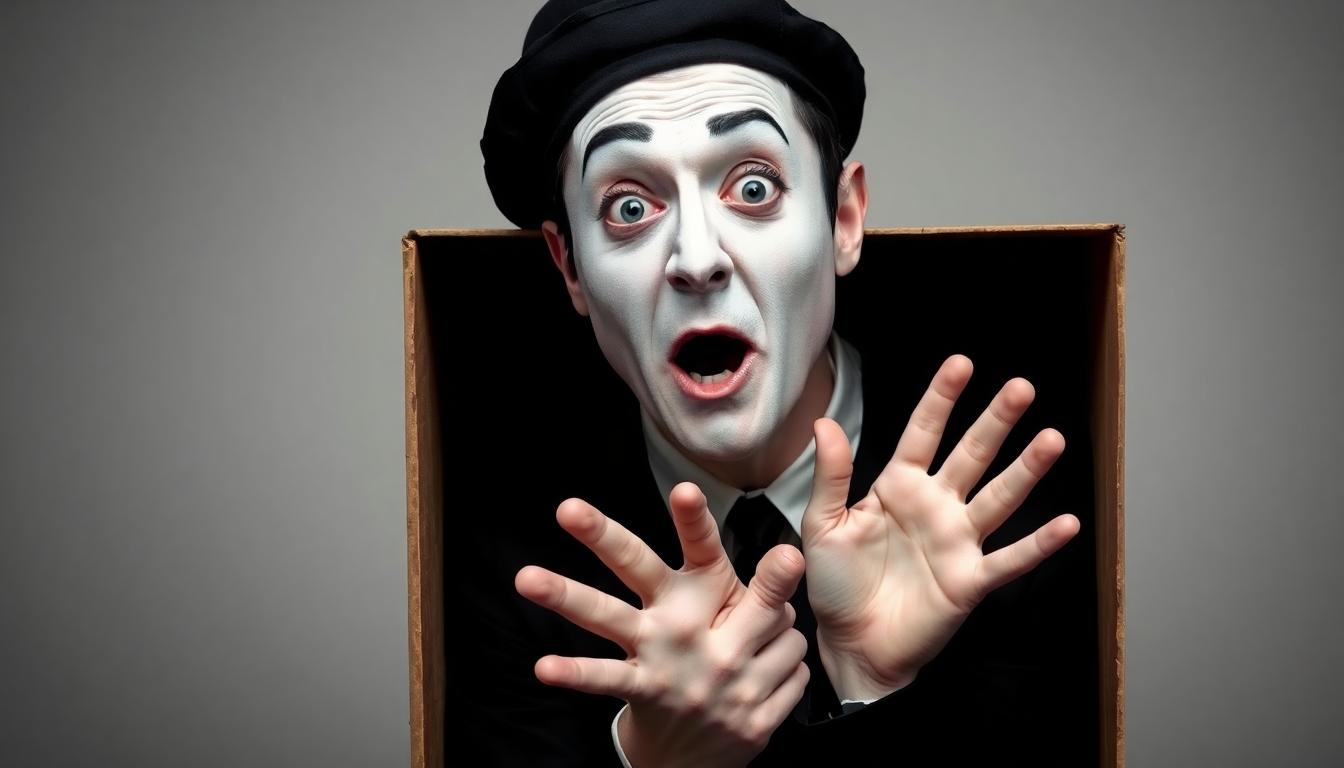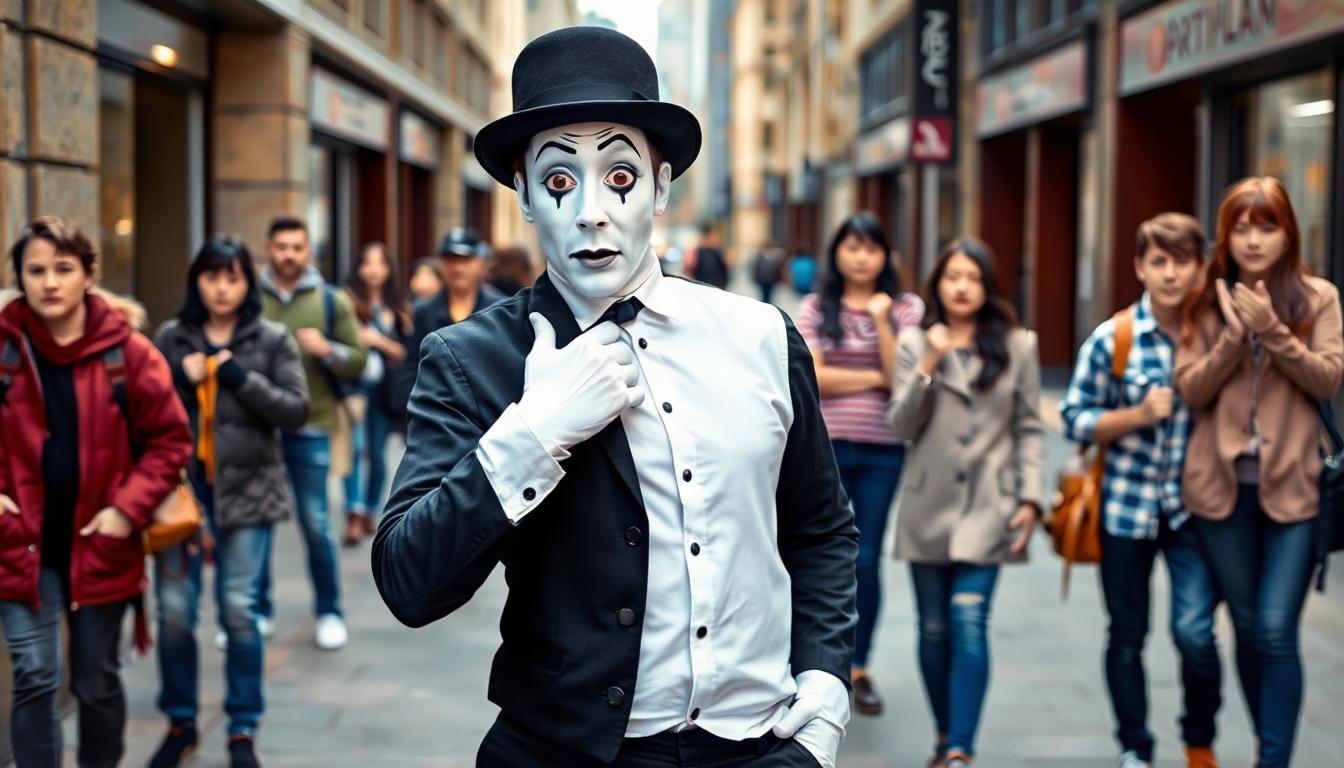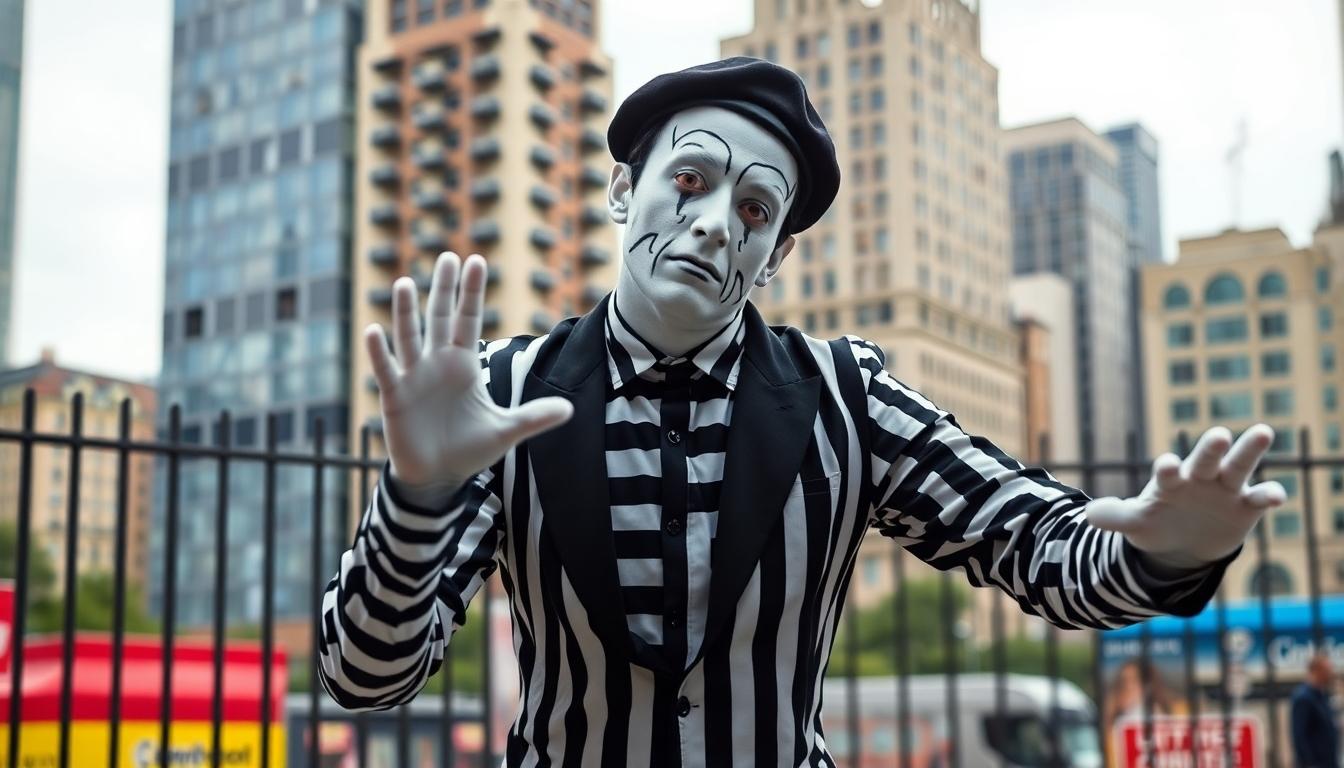Mimes—those silent performers who entertain us with exaggerated gestures and invisible props—have long been the subject of humor. We’ve all chuckled at their imaginary struggles against invisible winds or their desperate attempts to escape transparent boxes. But what makes mime jokes so universally appealing?
In this text, we’ll explore the funniest jokes about mimes that’ll leave you laughing out loud (silently, of course). From classic one-liners to witty observations about these white-faced artists, we’ve compiled the most entertaining mime humor on the internet. Whether you’re a fan of physical comedy or just need a good laugh, our collection of mime jokes has something for everyone.
10 Classic Pantomime Jokes That Will Leave You Speechless
Trapped In An Invisible Box
Why did the mime call tech support? His invisible box came with no escape key! We’ve all seen the classic mime routine where they’re desperately pushing against transparent walls, searching for a way out. A mime walks into a bar—or does he? The invisible barrier stops him just before entering, forcing him to theatrically slide down the unseen wall while onlookers chuckle. Police once arrested a mime for disorderly conduct, but couldn’t contain him in any cell—he kept escaping through imaginary doors! During a mime’s performance, an audience member shouted, “How do you get out of that box?” The mime just shrugged dramatically, proving some traps are truly inescapable. Many performers have elevated this routine to an art form, adding elements like testing the dimensions, attempting to lift the box, or frantically looking for invisible hinges that simply aren’t there.
The Imaginary Rope Pull
Watching a mime struggle with an invisible tug-of-war never gets old—especially when they’re clearly losing to absolutely nothing! Two mimes once had a rope-pulling contest, leaving spectators genuinely unsure which nonexistent rope would snap first. During street performances, clever mimes sometimes “attach” their invisible rope to unwitting passersby, creating hilarious interactions as the person unknowingly “pulls back.” One mime’s rope routine went viral when a child actually began helping him pull the imaginary load, demonstrating the universal language of pantomime. Professional mime artists often incorporate elaborate scenarios with their rope pulls—scaling buildings, taming wild animals, or dramatically saving someone from falling. The beauty of this classic bit lies in its versatility; the mime can transform the rope into countless objects like a lasso, jump rope, or fishing line with just a slight change in gesture and facial expression.
Why Mime Jokes Work: The Psychology Behind Silent Comedy

Mime humor connects with audiences through fundamental psychological principles that make silent comedy universally appealing and effective. The absence of words creates a unique comedic experience that resonates across cultures and languages.
The Universal Language Of Physical Humor
Physical comedy transcends linguistic barriers through exaggerated gestures and facial expressions that everyone can understand. Mimes leverage universal physicality to communicate humor without saying a word, making their performances accessible to diverse audiences worldwide. Their hyperbolic movements—tugging invisible ropes or walking against imaginary winds—become inherently comedic through the amplification of everyday actions. Body illusions force viewers to mentally complete the scene, creating a collaborative experience between performer and audience. This participatory element transforms simple acts like pressing against a non-existent wall into moments of shared humor. Research shows that through embodied cognition, our brains actually simulate the mime’s actions, converting abstract gestures into tangible, relatable experiences that trigger our laughter response.
The Power Of Imagination
Silence in mime performances compels audiences to actively project meaning onto actions, establishing a unique collaborative joke structure. When a mime appears trapped in an invisible box, viewers must mentally construct the constraints, creating an captivating dissonance between perception and imagination. This ever-changing perfectly aligns with established humor theories centered on incongruity—where laughter emerges from the mismatch between expectations and reality. Mimes create a mental playground where audiences become co-creators of the comedy, filling in missing details with their own imagination. The visceral, wordless interactions highlight the primal appeal of physical storytelling, as viewers participate in constructing the joke’s punchline. We find this collaborative aspect particularly powerful because it engages the audience’s creativity, making mime jokes more personally meaningful than many spoken forms of comedy.
7 Famous Mimes Who Mastered The Art Of Silent Jokes

While traditional comedy relies on witty punchlines, these legendary performers proved that silence can speak volumes when it comes to humor. Their mastery of physical expression turned simple movements into memorable comedic moments that transcend language barriers.
- Marcel Marceau – This legendary French performer revolutionized mime through his iconic “Bip the Clown” character, bringing silent comedy to international acclaim and influencing generations of performers.
- Jean-Gaspard Deburau – As the creator of the beloved “Pierrot” character, Deburau established many fundamental techniques still used in mime comedy today, earning him recognition as the father of modern mime.
- Jacques Lecoq – Beyond performing, Lecoq developed comprehensive training methods that emphasized physical comedy and helped formalize mime as a respected artistic discipline.
- Étienne Decroux – His theoretical contributions to mime transformed it from street entertainment to high art, establishing principles that continue to guide comedic silent performances worldwide.
- Jean-Louis Barrault – After studying under Jacques Copeau, Barrault blended classical theatrical training with mime techniques to create uniquely expressive comedic performances.
- Jacques Tati – Incorporating mime principles into filmmaking, Tati created visual gags that minimized dialogue and maximized physical humor, bringing mime techniques to cinema audiences.
- Charlie Chaplin – Though not strictly classified as a mime, Chaplin’s silent film performances incorporated mime-like physical comedy that influenced countless performers across multiple disciplines.
Marcel Marceau’s Timeless Gags
Marcel Marceau elevated mime from street performance to high art through his masterful silent comedy routines. His character “Bip the Clown,” distinguished by a striped shirt and battered hat topped with a red flower, became universally recognized for storytelling through gesture alone. Marceau’s famous “Walking Against the Wind” routine demonstrated his extraordinary ability to create something tangible from nothing, making audiences feel the invisible force pushing against him. His “Mask Maker” performance showcased his remarkable facial control as he shifted between expressions of joy and sorrow with lightning speed. These weren’t merely silent jokes but intricate narratives told entirely through movement, creating laughter and emotion without uttering a single word.
Contemporary Mime Comedians
Today’s performers continue the tradition of silent comedy while adding modern twists to this ancient art form. Contemporary artists often blend traditional mime techniques with other performance styles, creating hybrid shows that incorporate elements of stand-up, improvisation, and physical theater. Modern mime comedians frequently break the fourth wall, directly captivating audiences in their silent narratives to create shared moments of humor. Street performers worldwide draw from mime traditions, using exaggerated movements and facial expressions to entertain crowds without words. Though not always labeled specifically as “mime comedians,” many contemporary physical comedians and clowns incorporate important mime elements into their acts, keeping this distinctive form of silent humor alive for new generations. The influence of pioneering mimes continues to resonate throughout modern entertainment, from theater stages to viral social media performances.
How To Tell A Great Mime Joke Without Saying A Word

Creating a great mime joke requires mastering the art of silent communication. We’ve compiled essential techniques to help you deliver side-splitting mime jokes without uttering a single word.
Facial Expressions That Speak Volumes
Facial expressions form the cornerstone of effective mime comedy. Your face must communicate what your voice cannot, turning simple gestures into hilarious moments that resonate with audiences. Exaggerated expressions—like widened eyes for surprise or an overly furrowed brow for confusion—can transform ordinary movements into comedic gold. Professional mimes spend years perfecting their facial control, ensuring they can convey complex emotions from joy to bewilderment with just a slight adjustment of their features. When performing mime jokes, remember that your facial reactions often deliver the punchline more effectively than any invisible prop you might be manipulating.
Timing Is Everything
The perfect execution of mime jokes hinges on impeccable timing. A well-timed pause creates anticipation, while rhythmic movements build comedic tension that pays off with bigger laughs. Mimes must master the art of holding a gesture just long enough before transitioning to the unexpected twist or revelation. For instance, when performing an “invisible box” routine, allowing the audience to fully absorb your trapped predicament before attempting your escape maximizes the humor. Professional mime comedians often use dramatic pauses strategically—letting the audience’s imagination catch up with the scenario before delivering the visual punchline. This deliberate pacing transforms simple actions into memorable comedic moments without requiring any words.
Set Up the Scene
Establishing a clear scenario forms the foundation of any successful mime joke. We recommend starting with recognizable situations—like pretending to walk a dog or eat spaghetti—that audiences can immediately identify. Create a visual framework by carefully defining your invisible environment through precise movements. For example, if mimicking a restaurant scene, clearly indicate the table’s height, chair position, and the presence of utensils before introducing the comedic element. This thorough setup ensures your audience follows along, making the eventual joke land with maximum impact.
Exaggerate the Action
Amplification transforms ordinary movements into extraordinary comedy. Take everyday actions and stretch them beyond reality—struggle dramatically with an umbrella in imaginary wind or react with over-the-top shock when your invisible ice cream melts onto your shoes. These exaggerated reactions create visual humor that transcends language barriers. Professional mimes often use progressive exaggeration, starting with a believable action before gradually intensifying both the movement and emotional response until reaching an absurd climax that guarantees laughs.
Timing and Pause
Mastering the strategic pause elevates mime comedy from amusing to unforgettable. We’ve observed that the most successful mime jokes incorporate a well-timed hesitation just before the visual punchline, building anticipation that makes the payoff more satisfying. This technique creates space for the audience’s imagination to engage, turning them into active participants rather than passive observers. For maximum impact, hold your final gesture slightly longer than feels natural—this extended beat allows the humor to sink in fully and often triggers the biggest response from your audience.
When Mime Jokes Go Wrong: Awkward Silent Moments

Even the most talented mimes occasionally find themselves in cringe-worthy situations when their silent comedy doesn’t land as intended. Even though their careful planning and practiced movements, mime performances can sometimes lead to unexpected and uncomfortable moments.
The classic “invisible bank robbery” scenario has backfired many times in public spaces. One notable incident involved a mime who pretended to rob an invisible bank, complete with exaggerated sneaking movements and pantomimed gun gestures. Concerned onlookers, unable to distinguish between performance art and potential threat, called the police. When officers arrived, the mime had to break character to explain that the “stolen money” was just air, turning what was meant to be comedy into an awkward encounter with law enforcement.
Misunderstandings between mimes and their audiences create particularly uncomfortable situations. In one instance, a lost tourist approached a mime for directions, genuinely needing assistance in a foreign city. The performer enthusiastically nodded and began miming an elaborate route with sweeping arm movements and invisible landmark references. The confused tourist stood there scratching their head until a helpful local stepped in to provide actual verbal directions, leaving the mime’s performance hanging awkwardly in the air.
Communication breakdowns also occur between mimes themselves, leading to unexpected and sometimes humorous results. Two street performers once got into a pretend argument, using angry gestures and even miming throwing imaginary pies at each other. When a curious passerby asked what they were arguing about, one mime unexpectedly broke character and said, “We’re having a disagreement about silence!” This sudden verbal response not only surprised the audience but also transformed their silent act into an ironic moment of spoken comedy.
Performance spaces present their own challenges for mime jokes. Public areas that are too noisy or distracting can diminish the impact of silent comedy, causing mimes to work harder for attention and recognition. Without the context of a theater setting, passersby might not realize they’re witnessing a performance at all, creating an awkward situation where the mime appears to be behaving strangely without purpose.
Technical mishaps add another layer of potential embarrassment to mime performances. Props that are supposed to remain hidden might suddenly become visible, or physical comedy requiring precise timing might go awry when a performer trips or stumbles unintentionally. These real accidents occurring during pretend scenarios create a meta-level of awkwardness that can either enhance the comedy or derail it completely.
Mime Jokes In Popular Culture And Entertainment

Mime humor has secured its place in mainstream entertainment with its distinctive blend of visual comedy and silent storytelling. The art form’s unique characteristics have made it a recurring comedic element across various media platforms.
Movies That Brilliantly Capture Mime Humor
The foundation of cinematic mime humor traces back to silent film legends like Charlie Chaplin, whose physical comedy techniques established many conventions still used today. Silent-era filmmakers mastered the art of communicating complex emotions and situations without dialogue, relying instead on exaggerated facial expressions and precise body movements. While contemporary films focused exclusively on mime artistry are relatively rare, elements of mime comedy frequently appear in modern cinema. These scenes typically highlight the contrast between a mime’s serious dedication to their create and the absurdity of their invisible scenarios. Classic mime routines, such as the imaginary traffic jam where performers create entire chaotic street scenes from thin air, have inspired countless cinematic moments where characters navigate through nonexistent obstacles for comedic effect.
Mime References In Television Comedy
Television shows regularly incorporate mime-related humor to create memorable comedic moments. The inherent visual nature of mime performances makes them perfect for TV comedy sketches, where the contrast between reality and pantomimed fiction creates rich opportunities for humor. Recurring television tropes include characters dramatically struggling against invisible barriers or miming elaborate disasters while maintaining completely serious expressions. The comedy often derives from the juxtaposition between the mime’s intense commitment to their imaginary scenario and the audience’s awareness of its nonexistence. Popular gags feature scenarios like invisible tug-of-war contests and the classic “trapped in a box” routine that has become almost synonymous with mime performance. These visual jokes work particularly well in television because they capitalize on the medium’s visual strengths while creating universally accessible humor that transcends language barriers.
The Future Of Mime Comedy In The Digital Age

Adaptation to Short-Form Video
Short-form video platforms like TikTok offer perfect venues for mime comedy to thrive in the digital industry. These platforms naturally prioritize visual storytelling and quick, relatable sketches—elements that align perfectly with mime’s physical expression strengths. Gen Z audiences show strong preferences for absurdist, visually-driven comedy, creating fertile ground for mime artists to showcase their talents. We’re seeing opportunities for mimes to innovate through exaggerated gestures and surreal scenarios, such as miming interactions with invisible digital interfaces or satirizing our technology-dependent lives through silent performance.
Hybrid Formats
Mime performers are beginning to integrate digital tools into their traditionally analog art form. Augmented reality (AR) enhancements can transform conventional mime performances into multimedia experiences while maintaining their silent essence. Creative combinations of traditional techniques with tech-driven visuals—like projecting virtual props or environments—modernize acts for digital-native audiences. These hybrid approaches allow mimes to preserve their fundamental reliance on physical storytelling while embracing technological evolution.
Viral Potential
Meme culture and mime comedy share surprising similarities in their reliance on simplicity and repetition. Clip-friendly moments featuring exaggerated reactions or looping physical gags have important potential to gain traction in online communities. Mime performances naturally lend themselves to shareable micro-content that can introduce the art form to younger audiences who might otherwise never encounter traditional mime. The visual nature of mime comedy makes it uniquely positioned to transcend language barriers in global social media environments.
Challenges
Digital humor’s rapid turnover presents substantial hurdles for mime comedy’s traditionally slow-burn style. Contemporary online content often favors snappy, audio-driven formats that contrast with mime’s silent approach. Mimes must strategically balance their wordless performances against trending content styles that rely heavily on dialogue and sound effects. We’re witnessing a fundamental tension between mime’s deliberate pacing and the accelerated consumption patterns of digital media, requiring thoughtful adaptation from performers.
Case Studies
While exact examples of successful digital-era mime acts remain relatively scarce, analogous trends suggest promising pathways forward. Silent physical comedians on platforms like TikTok, such as @zachnoe, demonstrate the continuing viability of non-verbal humor in short-form digital formats. These creators use exaggerated expressions and physical comedy to build substantial followings, providing a blueprint for how traditional mime techniques can be adapted for today’s digital audiences. Their success indicates that even though challenges, there remains important appetite for visual, wordless humor in the digital network.
The Last Laugh: Why We’ll Never Stop Joking About Mimes
Mime humor continues to captivate us with its universal appeal and timeless charm. From Marcel Marceau’s legendary performances to viral TikTok sketches we’re witnessing the evolution of an art form that transcends language barriers.
Whether you’re appreciating the classics or exploring digital-age adaptations the beauty of mime comedy lies in its ability to connect through shared imagination. We’ll always find joy in these silent storytellers who remind us that sometimes the funniest jokes don’t need words at all.
Next time you see a mime battling invisible winds or trapped in that classic box remember you’re experiencing a comedic tradition that’s been making people laugh for generations—and will continue to do so for many more.
Frequently Asked Questions
What makes mime jokes universally appealing?
Mime jokes transcend language barriers through physical comedy that everyone can understand. The absence of words creates a unique comedic experience that works across cultures. When mimes use exaggerated gestures and facial expressions, they communicate effectively without speech, turning simple actions into shared moments of humor. This universal language of physical comedy engages audiences by inviting them to complete the scene mentally.
Who are some of the most influential mime performers in history?
Marcel Marceau tops the list with his iconic character “Bip the Clown” and routines like “Walking Against the Wind.” Jean-Gaspard Deburau revolutionized the art in 19th century Paris. Jacques Tati blended mime with filmmaking. Other notable figures include Charlie Chaplin, whose silent film techniques incorporated mime elements, and contemporary performers who continue to evolve the tradition by blending classic techniques with modern performance styles.
How do you tell a great mime joke without speaking?
Master facial expressions—exaggerate them to enhance comedic moments. Perfect your timing with strategic pauses to build anticipation. Establish clear scenarios so audiences understand the context immediately. Exaggerate your movements to make actions more visible and impactful. Engage with your audience through eye contact and reactions. These techniques help viewers connect with your performance and create memorable, shared moments of humor.
Why do mime performances sometimes fail to land with audiences?
Mime performances can fail when the scenario isn’t clearly established, leaving audiences confused. Miscommunications between performers and viewers can lead to awkward moments or misinterpretations. Technical mishaps or props that fail mid-routine can disrupt the comedic flow. Sometimes cultural references don’t translate universally. Additionally, the delicate balance between subtlety and exaggeration requires skill—too subtle and the joke is missed, too exaggerated and it can feel forced.
How has mime comedy evolved in popular culture and entertainment?
Mime comedy evolved from silent film legends like Charlie Chaplin to modern interpretations in film and television. While dedicated mime films are rare today, mime elements frequently appear as comedic devices in entertainment, showcasing the contrast between serious dedication and absurd invisible scenarios. Television shows leverage mime performances for visual humor that transcends language barriers. The art continues to adapt while maintaining its core silent storytelling essence.
How are mime artists adapting to the digital age?
Mime artists are thriving on short-form video platforms like TikTok, which favor visual storytelling and quick sketches. Many performers now integrate digital tools like augmented reality into their acts, creating hybrid formats that modernize the art while preserving its silent essence. These adaptations help mime comedy reach younger audiences through shareable micro-content. Despite challenges from rapid content turnover and audio-driven formats, mime’s visual nature positions it well for digital success.
What psychological elements make mime comedy effective?
Mime comedy leverages the audience’s imagination, compelling viewers to project meaning onto actions and participate mentally in completing the scene. This participatory aspect creates a collaborative experience more personally engaging than many spoken forms of comedy. The physicality triggers mirror neurons, causing viewers to empathetically feel what they see. Additionally, the constraint of silence forces creativity, often resulting in more innovative comedic solutions than verbal jokes.
Can anyone learn to perform mime comedy?
Yes, anyone can learn mime comedy with practice and dedication. Begin by studying facial control and body awareness through exercises like mirroring. Learn classic techniques such as the “invisible wall” and “rope pull.” Practice conveying clear emotions without words. Study successful mime performers for inspiration. Join workshops or classes for structured learning. While natural comedic timing helps, most mime skills can be developed through consistent practice and a willingness to embrace physical storytelling.







